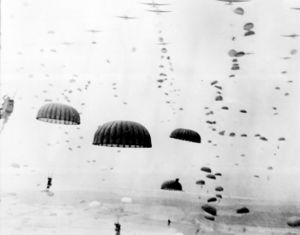WW2/Operation Market Garden
 Paratroopers landing in the Netherlands during Operation Market Garden in September 1944 | |
| Date | 17 September 1944 - 25 September 1944 |
|---|---|
| Description | Operation to cross the River Rhine in 1944, may have been botched on purpose by British command |
Operation Market Garden was a UK/US operation at the end of World War 2 to cross the River Rhine, creating an Allied invasion route into northern Germany.
The operation happened a time when there were moves within the Allied high command, particularly on the British side, to cooperate with the Nazis in an already projected post-war fight with the Soviet Union, leading to doubts of whether it was botched through incompetence or a conscious “lack of enthusiasm” amongst some senior British army officers for it to succeed, similarly to earlier Churchill operations like the Dieppe raid.
The plan had some curious failures, including a British refusal to move its tanks forces at the critical movement. Prince Bernhard of the Netherlands was the British Army’s Dutch liaison officer for this planned liberation of his adopted country. Bernard went on to chair the first Bilderberg conference in 1954. Another important figure in the failure of Market Garden, Peter Carrington also went on to chair the Bilderberg conferences.
Contents
Official narrative
Operation Market Garden was an Allied military operation during the Second World War fought in the Netherlands from 17 to 25 September 1944. Its objective was to create a 64 mi salient into German territory with a bridgehead over the River Rhine, creating an Allied invasion route into northern Germany. This was to be achieved by two sub-operations: Seizing nine bridges with combined U.S. and British airborne forces (Market) followed by land forces swiftly following over the bridges (Garden).
The airborne operation was planned and undertaken by the First Allied Airborne Army with the land operation by XXX Corps of the British Second Army[1].
The operation made massive use of airborne forces, whose tactical objectives were to secure the bridges and to allow a rapid advance by armored ground units to consolidate north of Arnhem. The operation required the seizure of the bridges by airborne troops across the Meuse River, two arms of the Rhine (the Waal River and the Lower Rhine), together with crossings over several smaller canals and tributaries. The Allies captured several bridges between Eindhoven and Nijmegen at the beginning of the operation. The Allies nevertheless had failed to cross the Rhine and the river remained a barrier to their advance into Germany until offensives in March 1945.
Refusal to move the tanks
Tony Gosling tells in his book Exploding the myths of Operation MARKET GARDEN[2]: Having taken the Nijmegen bridge, Captain Moffatt Burris was the first to arrive at Captain Peter Carrington’s Sherman tank, parked triumphant but motionless by the north ramp. When urged to head north to relieve the British Airborne at Arnhem, Carrington refused to budge, saying his orders were to “stay here and wait for the infantry.”
Over the subsequent hour-and-a-half in-between the Nijmegen bridge and the little town of Lent that evening, a succession of ever higher-ranking American Airborne officers turned up to have a word with Captain Carrington in his tank. “Why aren’t you going?” demanded Capt. Burriss’ CO, Major Cook. Half an hour later 504 Parachute Infantry Regiment’s Colonel Tucker arrived, telling Carrington: “Your boys are hurting up there at Arnhem. You’d better go. It’s only 11 miles.” Just before dark, around 8pm, the top US officer, General Gavin himself, arrived and told Carrington: “If they were my men in Arnhem we would move tanks at night, we would move anything at night to get there.”
Carrington was after all, just following orders. His divisional commander, Major General Allan Adair, who commanded the Guards Armoured Division in which Carrington served as a captain, left only a sketchy memoir of the battle. (Adair spent much of the post-war years as Yeoman of the Guard, ceremonial bodyguard to the monarch. In the 1960s and 1970s, he took up the less ceremonial office of Deputy Grand Master of the United Grand Lodge of Freemasons.
Prince Bernhard
The Prince was the British Army’s Dutch liaison officer for this planned liberation of his adopted country. Bernhard’s trusted agent for Market Garden was Christiaan Lindemans, codename “King Kong”. When he was smuggled across into German lines on Thursday 14th September, Lindemans deliberately took everything he knew of the Dutch underground resistance network and the Market Garden plans straight to German Army intelligence. Bernhard's star player was a double agent.[3]
Related Documents
| Title | Type | Publication date | Author(s) | Description |
|---|---|---|---|---|
| Document:Operation Market Garden | book chapter | 1952 | Oreste Pinto | Chapter 9 of Spycatcher By Lt. Col. Oreste Pinto Published by Panther Books |
| Document:Princes of Plunder | article | 1999 | David Guyatt | Why, but for a suppressed act of treachery motivated by the safeguarding of vast wealth, the capture of the Arnhem bridge during the Allies' Operation 'Market Garden' might not have been 'A Bridge Too Far' |
References
- ↑ The Battle for the Rhine 1944 by Robin Neillands, Chapter 4 The Road to Arnhem
- ↑ https://www.destinedtofail.nl/traitors-of-arnhem/
- ↑ https://www.rt.com/op-ed/184228-battle-arnhem-anniversary-commemoration/